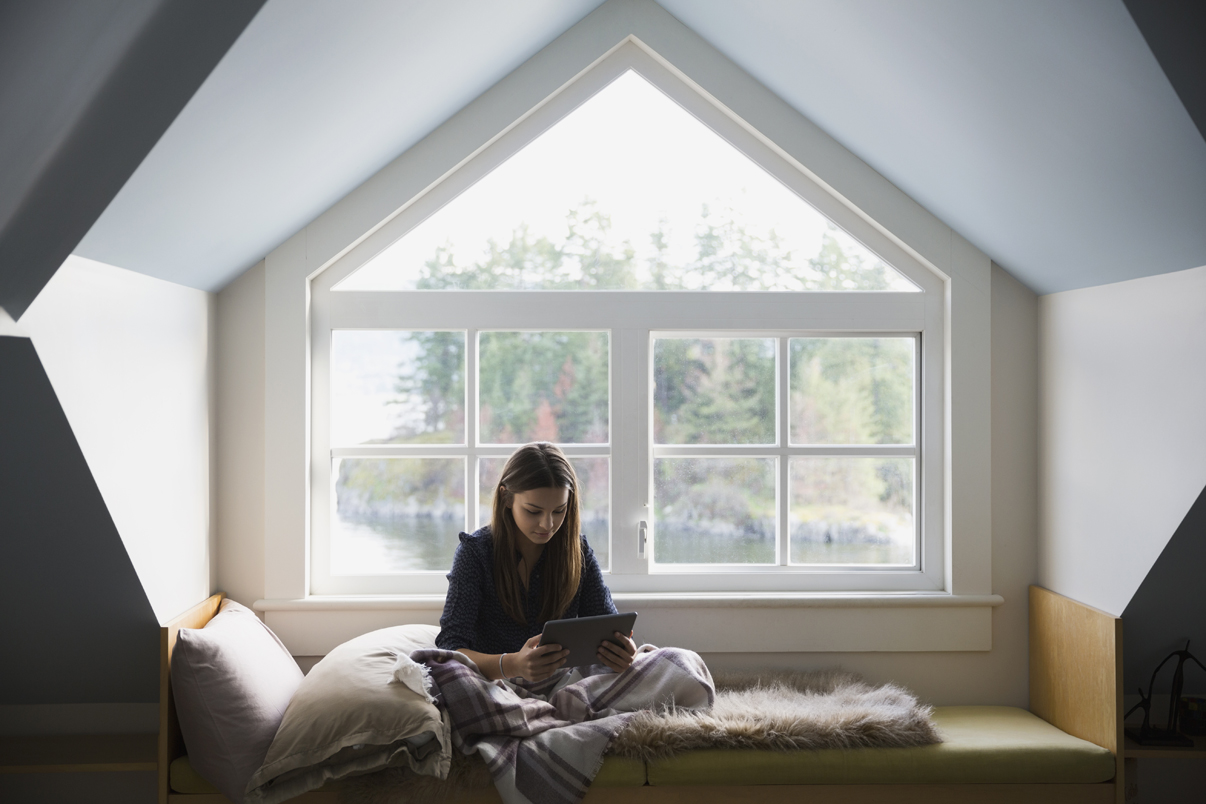In the late ‘90s, acclaimed architect Sarah Susanka made a radical suggestion: Maybe we should build houses that are not so big. In the nearly two decades since, that idea has become common sense, thanks largely to Susanka and her Not So Big series of books. Susanka argues that the key to happiness isn’t a palatial house filled with hordes of stuff; rather, happiness comes from finding inspiration in the little things. We talked to Susanka about how to create a fuller life by having less.
Mindful: What do you strive for when designing a house?
Sarah Susanka: When I’m designing a house, I try to make sure every square foot is lived in every day. I also try to help the house become an expression of useful beauty. Think of a well-designed window seat. If it’s beautifully crafted, it invites you to sit there. It’s small, but it becomes the treasure of the house. It’s a place you really want to be. It’s a place between inside and outside. It’s charming, and it makes you want to sit down and relax. And I’m trying to make houses that make you want to say, “I’m safe. I’m sheltered. I can sit and enjoy the views. I’m home.”
Mindful: What do you mean when you talk about “rightsizing”?
SS: Contrary to what people expect, rightsizing doesn’t start with a notion of size, but with the question, “What do I need? What do I love?” What grows out of that is rightsized. Your quality of life is based on how you are in your space, not the size of it. So, when I say, “not so big,” it’s got a paradox right in the name. Because what I’m really trying to get people to see is that it’s not about the size at all. Some people think 1,200 square feet is way too big and others think 3,000 square feet is too small. I’m not there to judge. I’m there to help them discover what’s right.
I’m working with a woman right now who has two large rugs that are going to make the core of her house. They were her mother’s, and so she loves them dearly, so we are shaping the house around those rugs. Without them, we might make the house smaller. But, for her, rightsizing includes those pieces of her past.
Mindful: Why does rightsizing so often mean downsizing?
SS: A lot of the population has gone overboard. We’ve got more space and stuff than we need. We’ve equated more quantity with the notion of a better life. That’s a lie. When humans were living in very small, cramped spaces, bigger was probably an improvement. But there’s a point at which more square footage does not make a better life. We passed that point, most of us, quite a way back.
Mindful: How do you determine the right size for yourself?
SS: You have to observe yourself in different spaces to discover what feels right to you. You need to pay attention to what your body tells you about a space and its size. You can learn a lot from being in friends’ houses or going to open houses and architects’ house walkthroughs.
Mindful: When you say, “what your body tells you,” what do you mean?
SS: I’ll give you some examples.
Sometimes I notice that a client of mine feels uncomfortable sitting with their back to the door—they don’t like not knowing what’s going on behind them. Knowing that, I might design them a different shape of room. I might orient the kitchen table differently, so that the longer sides are in an alcove, and maybe even put the kitchen island close by, to give a sense of protection. It’s like tailoring a suit for a body rather than just putting on a sack.
Another example: right now, I’m in what I call my “inner office.” It’s a room in the roof of my house, with a sloped ceiling that comes down to about three feet at the edges of the room. At the center it’s eight feet. I love it. It feels like I’m wearing a big hat. But I have worked with many clients who go nuts in this type of space because they feel cramped.
I have my clients keep a little journal of places they love, memories, friends’ houses, and pictures from magazines. If you pay attention, you can learn quite a bit about what makes you feel comfortable or uncomfortable. And this becomes more important, the smaller the space.
Mindful: How do you see your clients’ outlook and priorities change once they move into a smaller space?
SS: When you put multiple people in a smaller space, they tend to interact more. Some of my clients get to know their families again, in a totally different way. When we’re living in a larger structure, we float away from each other. In a smaller space, gathering becomes more of a celebration. There’s not as many places to be, so you group together. I think that’s a wonderful thing about smaller structures.
I know an interior designer who remodeled his one-and-a-half-story house, and his 10-year-old daughter found that it became her friends’ favorite place to hang out. It was also the smallest. But it was really cool. It was the place with nooks and crannies, interesting spots to play hide and seek, and a sense of being in an adult world and a child world simultaneously.
Mindful: What is “breathing space,” and how can you create more breathing space in a smaller home?
SS: This is really key. And it’s counterintuitive. Breathing space is where you take a pause before you move into another space. In many older and smaller houses, you enter the front door and—bam!—you’re right in the main living space. That’s an example of no breathing space. You can feel very awkward there.
When something is beautiful and tailored to the right scale, your everyday life is enhanced tremendously. It reminds you why you’re alive.
If you have a very tiny landing space at the top of the stairs before you go into a bedroom, the house feels cramped. Adding extra square footage at the top of the stairs might seem like a waste, but it’s not. It gives you the opportunity to transition before you move into the bedrooms. It’s paradoxical, and a lot of what I talk about is paradoxical, because it’s not useful in our normal way of thinking. And yet, psychologically, it’s incredibly important.
Mindful: In your opinion, what are the most significant benefits of going smaller?
SS: On a sustainability level, a smaller house uses fewer resources and is easier to heat and cool. Furthermore, I think that making your home beautiful is a very big step in making it sustainable. When people love the place they live, they look after it.
On a design level, when something is beautiful and tailored to the right scale, your everyday life is enhanced tremendously. I think that happens for two reasons. One: what you end up with is beautiful and reminds you why you’re alive. It reflects you back to yourself in a way that brings joy and peace into your life. Two: in the process of creating, there’s a sense of something more, like when you paint or write a poem. Our lives are enhanced by living in something in which we have had creative expression.
Mindful: How can those of us without the cash to build a new house implement the Not So Big philosophy?
SS: After one talk I gave, the event bartender came up to me and said, “your comments gave me hundreds of ideas for how to make my trailer better.” She said she wanted to put a lighted painting at the end of a walkway—which gives the same feeling as having a window—and create ceiling height changes by hanging a billow of drape from the ceiling. “I can do these little things,” she said. “And it’ll make it mine.”
I call these “not so big moves”—little things you can do that make a big difference. In many ways, these low-budget changes can generate a much more creative response than designing a brand new house. It’s like when you write a poem in a particular form, you’ve got to be creative to work within that form. I think that’s why remodeling can be quite fun.
Mindful: What do you think is the impact of Not So Big on society at large?
SS: The impact is bigger than I originally thought it would be. And these ideas became important questions during the recession. Now, I’m seeing how deeply the roots of Not So Big have affected the culture as a whole. Ideas that were brandnew in the late ‘90s are now common sense. In the beginning, I was asking, “Do you really need a formal living room and a formal dining room?” Now, it’s standard to not build those rooms unless you need them. After The Not So Big House came out in ‘98, I can’t count how many reporters asked me, “Why would anybody want to downsize?” Like, “What planet are you from?” [laughs]
Fundamentally, I want people to see that they can have a very big life by focusing on meaningfulness. That’s what you remember when you’re on your deathbed. It doesn’t matter how many cars you’ve had or how big your house was. If you’ve lived a meaningful life, that’s what matters.
Make It Yours
You don’t need to buy a new house or make substantial renovations to get more from your living space. These three tips from Sarah Susanka will help you to take a second look at the spaces around you so you can better tailor your home to your life.
1. Make a List
Make a list of the rooms in your home, along with their approximate square footage and the activities that take place in each. Estimate the frequency of each activity and—if you live with others—who participates. Then rank the rooms in order of most used to least used. The point is to identify how you occupy your space so you can better tailor your home to your needs and create meaningful, uplifting spaces.
2. Measure It
Carry a tape measure with you for a while, and as you go about your life, notice how you respond to different spaces you encounter, whether it’s a grand historic building or a copy room at the office. If you can, measure the proportions of the spaces (including ceiling height) and record them in a notebook. Consider what spaces feel good, and if they appeal to you in an emotional or physical way. Try to articulate why, and how you might incorporate any elements of those spaces into your home.
3. Keep a Journal
In a three-ring binder or notebook, assemble data about places in your life that make you feel comfortable or uncomfortable. Document their size, take photos, even make diagrams illustrating what in the space evokes a response. Supplement your notes with images that catch your eye in magazines or online.

The Little Things
Sarah Susanka has lots of simple, crafty ways to make your home shine brighter and feel more spacious. Here are three favorites.
1. Go Toward the Light
“We are programmed physiologically to move toward light. On their own, many hallways feel like dead ends, which is why architects often put a window at the far end of a walkway. If you don’t have the means or desire to renovate, try putting a lighted painting at the end of a hallway. It can change your whole attitude toward that wing of the house.”
2. Add a Touch of Lipstick
“By adding a surprisingly strong color to a small area, like window trim, you can make your whole house pop—just like applying lipstick. The color will bring the entire surface to life. Generally, too much of a strong color can be overpowering. But a little taste can go a long way.”

3. Create a Shoji Screen Illusion
“Attach several Shoji screens to a wall to create an optical illusion of more space. I cannot tell you how many people will just assume there’s another room behind them. You could also run a line of LED lights along the baseboard behind the screens to create a beautiful wash of light.”
A Place of Your Own
A well-designed home should include some space set aside just for you.

Sarah Susanka’s Not So Big movement began when she made a small change in her own home: She turned her attic into a space where she could be alone and do what she loved. At the time, that was mostly meditation.
As she meditated, she says, “everything started to shift.” Susanka realized she wanted to write, and—in her private space—began work on her “Not So Big” series.
Susanka included the idea of a personal room in the series, and dubbed it “A Place of Your Own,” or “Poyo.” A Poyo is meant to be a space that is a reflection of yourself, where you can be yourself. As you spend time in it, you learn about yourself. “It tends to wake up something inside you,” says Susanka.
That process can be poignant. Susanka says that once you create that space, you start using it for what you care about—be that writing, painting, meditating, or bathing.
“It’s a place that allows you to express the part of yourself that normally doesn’t get to breathe,” says Susanka.
A Poyo should be somewhat private, but it can be any size. It could be an attic or spare room—or it could be a screened-off section of a bedroom, a loft, or a window seat. You can fill it with sentimental items, supplies for your hobby, or just one thing you really love. The most important thing is to make it your own.



